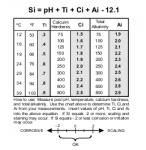I have been playing with the various goal ranges suggested by the Poolmath web page and comparing its suggestions with what it says in my SWG manual. I am wondering about the difference between the "Traditional Pool" and "Troublefree Pool" settings. The "Traditional" goals pretty match what is in the SWG manual while the TFP goals tend to be a little higher and a little tighter. Is there an explanation somewhere about how these numbers were arrived at?
For example, the SWG manual says CH between 200 and 400, but Poolmath says 350 to 450. Raising my pool from its current 240 to 350 requires 10 pounds of Calcium Chloride. I want to know why this difference.
For example, the SWG manual says CH between 200 and 400, but Poolmath says 350 to 450. Raising my pool from its current 240 to 350 requires 10 pounds of Calcium Chloride. I want to know why this difference.


